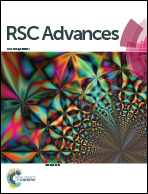A sustainable hierarchical carbon derived from cultivated fibroid fungus for high performance lithium–sulfur batteries†
Abstract
Biomass plays an important role in constructing carbon materials, but is always restricted by the non-tunable and non-standard characteristics of its precursors. In this study, we employed a new sustainable microorganism-route to synthesize the fibroid fungus that could be used as the precursor to prepare sulfur host materials for lithium sulfur batteries. The H3PO4-activated fibroid fungus presents a controllable nano- and micro-structure after high temperature carbonization, which can effectively suppress polysulfides dissolution and supply space for sulfur accommodation due to its high specific surface area of 509 m2 g−1 and pore volume of 0.69 m3 g−1. As a result, the assembled lithium sulfur (Li–S) battery shows a high initial specific discharge capacity of 1319 mA h g−1 at 0.1C and maintains a capacity of 663 mA h g−1 after 100 cycles, corresponding to the outstanding reaction kinetics and cycling stability. Our results display an eco-friendly, renewable and controlled synthesis process of porous carbon, which features a promising application in preparing versatile electrodes in energy storage.



 Please wait while we load your content...
Please wait while we load your content...